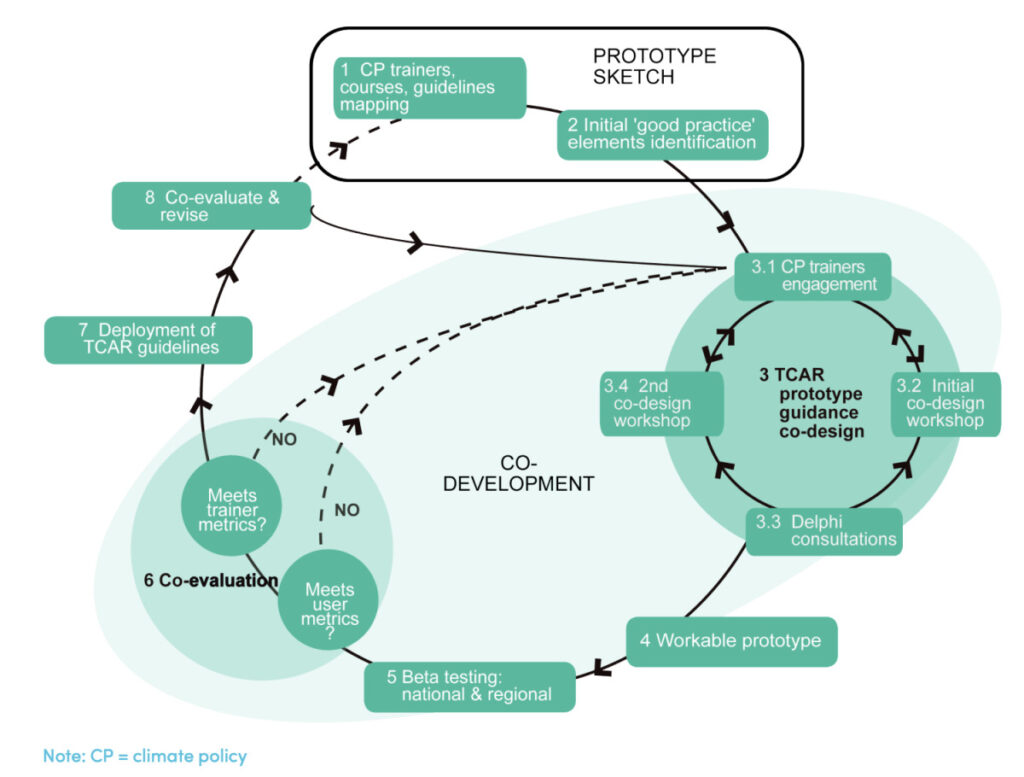Developing guidance on managing transboundary climate risks in adaptation and sectoral planning

Introduction
There is a critical need to develop guidance for incorporating transboundary climate risks (TCARs), including adaptation and mitigation risks, within climate policy and planning processes.
The Least Developed Countries Expert Group (LEG), established in 2001 under the UNFCCC, developed the 2012 Technical Guidelines for the National Adaptation Plan Process for countries looking to embark on the National Adaptation Plan (NAP) process. A major challenge remains, however, in recognising and managing TCARs within national planning processes.
This document is a concept note presenting a process for moving from prototype to fully operational (and widely deployed) guidance on mainstreaming TCARs within policy and practice that is in line with, and in support of, existing UNFCCC NAP, Nationally Determined Contributions (NDC) and long-term strategies (LTS) guidance. It does this by offering four key considerations for developing credible and salient guidance to manage transboundary climate risks, including the need for an iterative and multi-step process, the need for a dedicated champion to drive it, and the need for collaboration between developers of the guidance, those who will deliver it, and the end users.
This article is an abridged version of the original text, which can be downloaded from the right-hand column. Please access the original text for more detail, research purposes, full references, or to quote text.
Moving from idea to prototype to functional guidance
This concept note is designed to complement the 25 key actions put forward in A roadmap for African resilience: addressing transboundary and cascading climate risks. However, the process for co-developing guidance on TCARs is not limited to Africa; the International Centre for Integrated Mountain Development (ICIMOD) is working with member countries across the Hindu Kush Himalaya to build understanding of transboundary climate risks and increase governments’ capacities to respond. Other organisations are also seeking to enhance understanding of TCARs and options for their management in work with government and private sectors. Thus, such guidance would need to be applicable across many regions.
To meet this global challenge, there are several key considerations for developing credible and salient guidance on TCAR risk management in support of NAPs, regional adaptation planning and other climate policy planning processes:
- The development of the guidance needs to be an iterative process, to allow for the incorporation of new data and information, and shifting policy processes and needs within climate planning.
- A dedicated champion should drive the process.
- The guidance needs to be flexible, yet adhere to what is known about good practice in climate risk management.
The guidance should be co-developed with those likely to deliver it, and also involve policy and other decision makers who might utilise the guidance in policy and programming design, prioritisation and funding, and monitoring. This helps to keep the guidance credible and salient to intended audiences and relatable to their decision contexts, and encourages risk ownership.

Co-development process
In keeping with an iterative process, co-development on TCAR guidance could entail the following steps:
Steps 1 and 2 – a mapping of existing trainers/NAP/climate policy support groups and their modalities of support needs to be undertaken, and their guidelines reviewed, to create a first sketch for the prototype guidance.
Steps 3 and 4 – as the original NAP technical guidelines were co-designed through an extensive consultation process, so too should guidance for TCAR management within national, regional and continental climate planning processes be co-designed with a broad range of stakeholders.
Steps 5 and 6 – the prototype guidance needs to be tested with a select set of NAP planners, regional adaptation planners and climate policy makers to learn how usable it is for their decision contexts, what elements remain unclear or unworkable and what might be missing. Those trainers who support climate policy planning processes also need to evaluate how the prototype guidance is performing when they deliver support and training. This can help illuminate some of the barriers and enablers in different contexts.
Steps 6 and 7 – feedback and learning-by-doing from both trainers and climate policy makers will prompt refinement of the prototype guidelines, possibly through one more co-design workshop or via Delphi consultations. The refined guidelines will then be disseminated more broadly.
Step 8 – as scientific knowledge of TCARs increases, tools for assessing them more robustly are developed and the guidance is deployed through training and adaptation planning support in which feedback is generated, the guidance will have to evolve.
Guidelines on TCAR management in support of NAPs, regional adaptation planning and other climate policy processes should not be considered finalised or ready for widespread public dissemination unless it has gone through this iterative, co-design process. Otherwise, ‘guidance’ will be watered down to ‘guidelines’ and become just another pdf on a website with little practical application or uptake.
Explore steps 1 and 2 in more detail on pages 12-15 and steps 3 to 8 on pages 15-17.
Conclusion
With an emerging evidence base for TCARs, and the increased awareness of policy gaps across critical sectors to address and manage them, the need for guidance across the full risk management cycle is critical (from assessment, to management mechanisms, to monitoring and evaluation). Adaptation Without Borders (AWB) can leverage existing expertise, partnerships and projects to lead a collaborative co-design process that would develop a prototype guidance as presented in this document. The goal is to ensure full integration of TCARs and alignment with existing adaptation and development planning and policy instruments – NAPs, NDCs and LTSs – and their integration and alignment with socioeconomic, trade, finance and other sectoral policies.
Learn more about steps towards realising TCAR guidance on pages 17-18 of the concept note.
Further resources
- Suggested Citation: Opitz-Stapleton, S., Lindsay, C. and Anisimov, A. (2023) Developing guidance on managing TCARs in adaptation and sectoral planning. London: ODI. Available at: adaptationwithoutborders.org

(0) Comments
There is no content